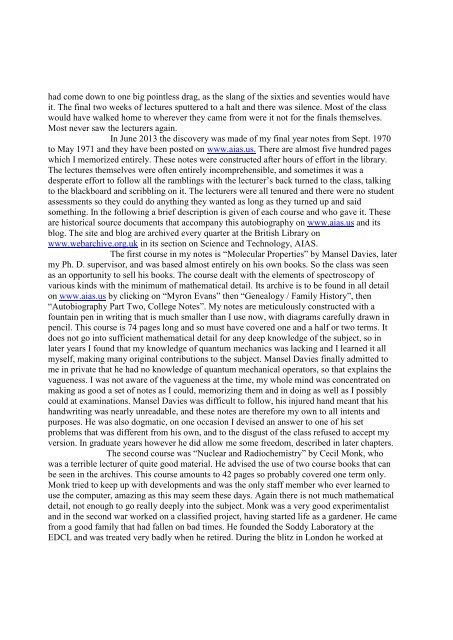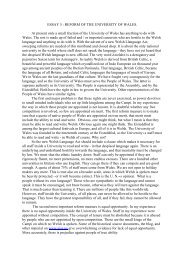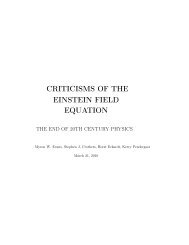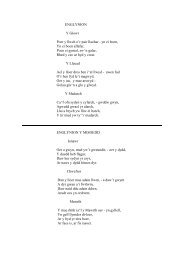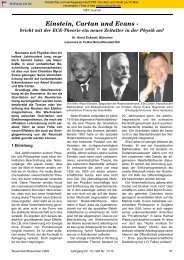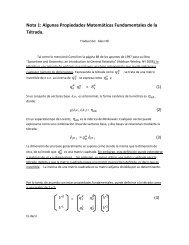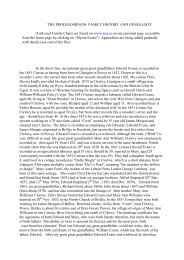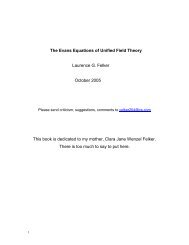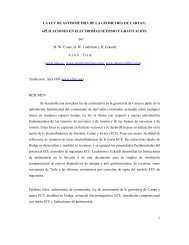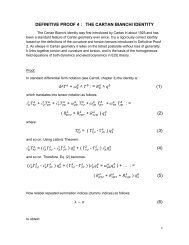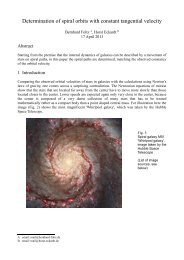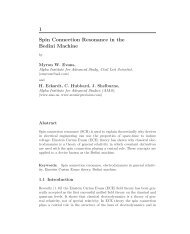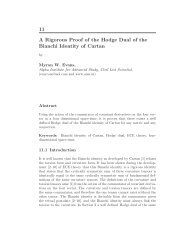Part 2 in process - Alpha Institute for Advanced Studies (AIAS)
Part 2 in process - Alpha Institute for Advanced Studies (AIAS)
Part 2 in process - Alpha Institute for Advanced Studies (AIAS)
You also want an ePaper? Increase the reach of your titles
YUMPU automatically turns print PDFs into web optimized ePapers that Google loves.
had come down to one big po<strong>in</strong>tless drag, as the slang of the sixties and seventies would have<br />
it. The f<strong>in</strong>al two weeks of lectures sputtered to a halt and there was silence. Most of the class<br />
would have walked home to wherever they came from were it not <strong>for</strong> the f<strong>in</strong>als themselves.<br />
Most never saw the lecturers aga<strong>in</strong>.<br />
In June 2013 the discovery was made of my f<strong>in</strong>al year notes from Sept. 1970<br />
to May 1971 and they have been posted on www.aias.us. There are almost five hundred pages<br />
which I memorized entirely. These notes were constructed after hours of ef<strong>for</strong>t <strong>in</strong> the library.<br />
The lectures themselves were often entirely <strong>in</strong>comprehensible, and sometimes it was a<br />
desperate ef<strong>for</strong>t to follow all the rambl<strong>in</strong>gs with the lecturer’s back turned to the class, talk<strong>in</strong>g<br />
to the blackboard and scribbl<strong>in</strong>g on it. The lecturers were all tenured and there were no student<br />
assessments so they could do anyth<strong>in</strong>g they wanted as long as they turned up and said<br />
someth<strong>in</strong>g. In the follow<strong>in</strong>g a brief description is given of each course and who gave it. These<br />
are historical source documents that accompany this autobiography on www.aias.us and its<br />
blog. The site and blog are archived every quarter at the British Library on<br />
www.webarchive.org.uk <strong>in</strong> its section on Science and Technology, <strong>AIAS</strong>.<br />
The first course <strong>in</strong> my notes is “Molecular Properties” by Mansel Davies, later<br />
my Ph. D. supervisor, and was based almost entirely on his own books. So the class was seen<br />
as an opportunity to sell his books. The course dealt with the elements of spectroscopy of<br />
various k<strong>in</strong>ds with the m<strong>in</strong>imum of mathematical detail. Its archive is to be found <strong>in</strong> all detail<br />
on www.aias.us by click<strong>in</strong>g on “Myron Evans” then “Genealogy / Family History”, then<br />
“Autobiography <strong>Part</strong> Two, College Notes”. My notes are meticulously constructed with a<br />
founta<strong>in</strong> pen <strong>in</strong> writ<strong>in</strong>g that is much smaller than I use now, with diagrams carefully drawn <strong>in</strong><br />
pencil. This course is 74 pages long and so must have covered one and a half or two terms. It<br />
does not go <strong>in</strong>to sufficient mathematical detail <strong>for</strong> any deep knowledge of the subject, so <strong>in</strong><br />
later years I found that my knowledge of quantum mechanics was lack<strong>in</strong>g and I learned it all<br />
myself, mak<strong>in</strong>g many orig<strong>in</strong>al contributions to the subject. Mansel Davies f<strong>in</strong>ally admitted to<br />
me <strong>in</strong> private that he had no knowledge of quantum mechanical operators, so that expla<strong>in</strong>s the<br />
vagueness. I was not aware of the vagueness at the time, my whole m<strong>in</strong>d was concentrated on<br />
mak<strong>in</strong>g as good a set of notes as I could, memoriz<strong>in</strong>g them and <strong>in</strong> do<strong>in</strong>g as well as I possibly<br />
could at exam<strong>in</strong>ations. Mansel Davies was difficult to follow, his <strong>in</strong>jured hand meant that his<br />
handwrit<strong>in</strong>g was nearly unreadable, and these notes are there<strong>for</strong>e my own to all <strong>in</strong>tents and<br />
purposes. He was also dogmatic, on one occasion I devised an answer to one of his set<br />
problems that was different from his own, and to the disgust of the class refused to accept my<br />
version. In graduate years however he did allow me some freedom, described <strong>in</strong> later chapters.<br />
The second course was “Nuclear and Radiochemistry” by Cecil Monk, who<br />
was a terrible lecturer of quite good material. He advised the use of two course books that can<br />
be seen <strong>in</strong> the archives. This course amounts to 42 pages so probably covered one term only.<br />
Monk tried to keep up with developments and was the only staff member who ever learned to<br />
use the computer, amaz<strong>in</strong>g as this may seem these days. Aga<strong>in</strong> there is not much mathematical<br />
detail, not enough to go really deeply <strong>in</strong>to the subject. Monk was a very good experimentalist<br />
and <strong>in</strong> the second war worked on a classified project, hav<strong>in</strong>g started life as a gardener. He came<br />
from a good family that had fallen on bad times. He founded the Soddy Laboratory at the<br />
EDCL and was treated very badly when he retired. Dur<strong>in</strong>g the blitz <strong>in</strong> London he worked at


